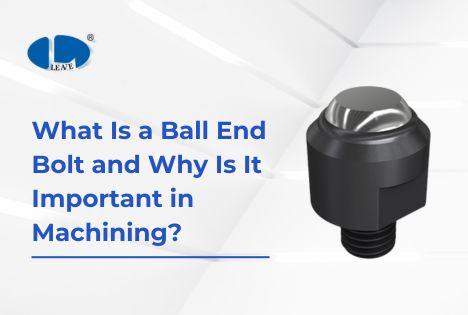Blog

Understanding Ball End Bolts
Ball end bolts are specialized fasteners designed for secure and stable clamping in machining and industrial applications. Unlike conventional bolts, their rounded ball head enables slight angular movement, allowing for flexibility in fixture setups while maintaining a strong hold. This adaptability makes ball end bolts a preferred choice in modular workholding systems, CNC machining, and precision assembly.
The ball end design is particularly advantageous in work environments where slight misalignments can occur. It ensures a uniform clamping force while reducing stress on both the bolt and the fixture, ultimately extending the lifespan of the components involved.
How Ball End Bolts Improve Machining Efficiency
The unique design of ball end bolts offers several advantages that enhance machining operations and assembly processes:
- ♦ Accommodates Misalignment – The ball end allows for slight angular adjustments, ensuring a firm grip even when alignment isn't perfect.
- ♦ Enhances Workholding Stability – Provides secure fastening, preventing unwanted movement of workpieces during machining.
- ♦ Optimizes Clamping Flexibility – Ideal for modular fixture setups, allowing easy adjustments for different workpiece shapes and sizes.
- ♦ Reduces Wear and Tear – Made from durable materials like alloy steel, these bolts withstand repeated use in high-pressure applications.
- ♦ Increases Safety – Secure clamping reduces the risk of workpieces shifting during high-speed machining, minimizing accidents and defects.
By integrating ball end bolts into modular fixture setups, manufacturers can achieve greater efficiency, improve repeatability, and enhance precision—all critical factors in high-performance machining environments.
Common Types of Ball End Bolts
Ball end bolts come in different variations, each tailored to specific applications:
- ♦ Standard Ball End Bolts – Used for general-purpose clamping and fastening in machining and industrial fixtures.
- ♦ Adjustable Ball End Bolts – Feature a movable ball end for increased flexibility in angular adjustments.
- ♦ High-Load Ball End Bolts – Designed for heavy-duty applications requiring greater tensile strength and clamping force.
- ♦ Corrosion-Resistant Ball End Bolts – Made from stainless steel or coated with protective finishes like black oxide or zinc plating for enhanced durability in harsh environments.
Selecting the right type of ball end bolt depends on the application's specific requirements, such as load-bearing capacity, environmental exposure, and precision needs.
Where Are Ball End Bolts Used?
Ball end bolts are widely used across industries that demand precision, stability, and efficiency:
- ♦ CNC Machining & Workholding – Ensures stability in modular fixtures and clamping systems, allowing for precision machining with minimal vibration.
- ♦ Automotive & Aerospace Manufacturing – Used in critical assemblies requiring strong, reliable fastening to withstand high-speed and high-temperature environments.
- ♦ Industrial Machinery – Secures machine components and workpieces during high-load operations, ensuring long-term performance and reliability.
- ♦ Precision Assembly – Ideal for electronics, tooling, and other high-accuracy applications where micro-level precision is necessary.
- ♦ Medical Equipment Manufacturing – Utilized in the production of medical devices and instruments that require non-slip fastening and easy adjustability.
In all these applications, the ability of ball end bolts to compensate for misalignment and provide stable clamping makes them an essential component in optimizing operational efficiency.
How to Maintain and Extend the Life of Ball End Bolts
To ensure long-lasting performance and reliability, regular maintenance of ball end bolts is essential. Here are some key maintenance tips:
- ♦ Regular Inspection – Check for signs of wear, corrosion, or thread damage, especially in high-load applications.
- ♦ Proper Lubrication – Apply anti-seize or lubricating compounds to prevent galling and ensure smooth operation.
- ♦ Tightening to Specified Torque – Over-tightening can weaken the bolt, while under-tightening may lead to inadequate clamping force.
- ♦ Replacement of Worn Bolts – If a bolt shows signs of excessive wear or fatigue, replace it immediately to prevent fixture failures.
Following these maintenance practices helps prevent downtime, improves performance, and extends the lifespan of ball end bolts in demanding industrial applications.
Choosing the Right Ball End Bolt
To maximize performance, consider these factors when selecting a ball end bolt:
- ♦ Material Strength – Opt for alloy steel or stainless steel for durability and resistance to wear.
- ♦ Thread Size & Pitch – Ensure compatibility with your fixture or clamping system.
- ♦ Load Capacity – Choose a bolt that can handle the required pressure and force without deformation.
- ♦ Coating & Finish – Look for corrosion-resistant coatings like black oxide or zinc plating for extended longevity.
- ♦ Application-Specific Features – Consider adjustable or high-load ball end bolts for specialized requirements.
By selecting the right ball end bolt, manufacturers can improve machining precision, reduce errors, and enhance overall productivity.
LEAVE's Modular Fastening Solutions
LEAVE provides a wide range of high-quality modular fastening components, including ball end bolts, to support precision machining and assembly. Our solutions are designed to enhance productivity, improve stability, and ensure reliable performance across various industries.
With over 1,000 standardized MC fixtures and modular solutions, LEAVE helps businesses optimize workholding efficiency while reducing setup times and production costs. Our ball end bolts are engineered for durability and precision, making them a trusted choice for manufacturers seeking high-quality fastening solutions.
Need a fastening solution for your machining setup? Contact our team today to explore how ball end bolts and modular fixtures can optimize your workholding system.
